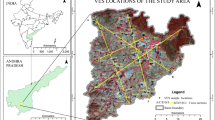Abstract
The increasing demand for freshwater has necessitated the exploration for new sources of groundwater, particularly in hard rock terrain, where groundwater is a vital source of freshwater. A fast, cost effective, and economical way of exploration is to study and analyze geophysical resistivity survey data. The present study area Omalur taluk, Salem District, Tamil Nadu, India, is overlain by Archaean crystalline metamorphic complex. The study area is a characteristic region of unconfined aquifer system. The potential for occurrence of groundwater in the study areas was classified as very good, good, moderate, and poor by interpreting the subsurface geophysical investigations, namely vertical electrical soundings, were carried out to delineate potential water-bearing zones. The studies reveal that the groundwater potential of shallow aquifers is due to weathered zone very low resistivity and very high thickness and the potential of deeper aquifers is determined by fracture zone very low resistivity and very high thickness area. By using conventional GIS method, the spatial distribution maps for different layer (top soil, weathered zone, first fracture zone, and second fracture zone) thicknesses were prepared. The geoelectrical approach was successfully applied in the study area and can be therefore easily adopted for similar environments.






Similar content being viewed by others
References
Baker TR, Case SB (2000) Let GIS be your guide. Science Teach 67(7):24–26, http://kangis.org/learning/publications/science_teacher/print/tst 0010_24.pdf
Bernard J, Valla P (1991) Groundwater exploration in fissured media with electrical and VLF methods. Geoexploration 27:81–91
Boerner FD, Schopper JR, Wller A (1996) Evaluation of transport and storage properties in the soil and groundwater zone from induced polarisation measurements. Geophysics 44:583–601
Christensen NB, Sorensen KI (1998) Surface and borehole electric and electromagnetic methods for hydrogeological investigations. Eur J Environ Eng Geophys 31:75–90
De Lima OAL, Niwas S (2000) Estimation of hydraulic parameters of shaly sandstone aquifers from geological measurements. J Hydrol 235:12–26
Fitterman DV, Stewart MT (1986) Transient electromagnetic sounding for groundwater. Geophysics 51:995–1005
Flathe H (1955) Possibilities and limitations in applying geoelectrical methods to hydrogeological problems in the coastal areas of North West Germany. Geophys Prospect 3:95–110
Huntley D (1986) Relations between permeability and electrical resistivity in granular aquifers. Groundwater 24(4):466–474
Kaikkonen P, Sharma SP (1997) Delineation of near-surface structures using VLF and VLF-R data-an insight from the joint inversion result. The Leading Edge 16(11):1683–1686
Karous M, Mares S (1988) Geophysical methods in studying fracture aquifers. Charles University, Prague, p 93
Kelly W (1977) Geoelectric sounding for estimating aquifer hydraulic conductivity. Groundwater 15(6):420–425
Kelly WE, Mares S (1993) Applied geophysics in hydrogeological and engineering practice. Elsevier, Amsterdam, p 289
Krishnamurthy NS, Kumar D, Rao Anand V, Jain SC, Ahmed S (2003) Comparison of surface and sub-surface geophysical investigations in delineating fracture zones. Curr Sci 84(9):1242–1246
Longley PA (2000) The academic success of GIS in geography: problems and prospects. J Geograph Sys 2(1):37–42
Mazac O, Kelly WE, Landa I (1985) A hydrogeophysical model for relations between electrical and hydraulic properties of aquifers. J Hydrol 79:1–19
Mazac O, Cislerova M, Vogel T (1988) Application of geophysical methods in describing spatial variability of saturated hydraulic conductivity in the zone of aeration. J Hydrol 103:117–126
Niwas S, Gupta PK, de Lima OAL (2006) Nonlinear electrical response of saturated shaley sand reservoir and its asymptotic approximations. Geophysics 71(3):129–133
Openshaw SA (1991) View on the crisis in geography, or using GIS to put humpty-dumpty back together again. Environ Plan 5(A 23):621–628
Porsani JL, Elis VR, Hiodo FY (2005) Geophysical investigations for the characterization of fractured rock aquifers in Itu, SE Brazil. J Appl Geophys 57:119–128
Ramtek RS, Venugopal K, Ghish N, Krishnaiah C, Panvaikar GA, Vaidya SD (2001) Remote sensing and surface geophysical techniques in the exploration of groundwater at Usha Ispat Ltd., Sindhurg Dist., Maharastra, India. Journal of IGU 5(1):41–49
Ronning Jan S, Lauritsen T, Mauring E (1995) LocatiNG bedrock fractures beneath alluvium using various geophysical methods. J Appl Geophys 34:137–167
Rubin Y, Hubbard Susan S (2005) Hydrogeophysics, water science and technology library, 50. Springer, The Netherlands, p 521
Shahid S, Nath SK (2002) GIS integration of remote sensing and electrical sounding data for hydrogeological exploration. J Spat Hydrol 2(1):1–12
Sharma SP, Baranwal VC (2005) Delineation of groundwater bearing fracture zones in a hard rock area integrating very low frequency electromagnetic and resistivity data. J Appl Geophys 57(155):166
Srivastava PK, Bhattacharya AK (2006) Groundwater assessment through an integrated approach using remote sensing, GIS and resistivity techniques: a case study from a hard rock terrain. Int J Remote Sens 27(20/20):4599–462
Sui D, Morrill R (2004) Computers and geography: from automated geography to digital earth. In: Brunn SD, Cutter SL, Harrington JW Jr (eds) Geography and technology. Kluwer, Dordrecht, NL
Teeuw RM (1999) Groundwater exploration using remote sensing and a low-cost geographical information system. Hydrogeol J 3:21–30
Zohdy AAR (1969) The use of Schlumberger and equatorial soundings in ground-water investigations near El Paso, Texas. Geophysics 34:713–728
Author information
Authors and Affiliations
Corresponding author
Rights and permissions
About this article
Cite this article
Karunanidhi, D., Vennila, G., Suresh, M. et al. Geoelectrical Schlumberger investigation for characterizing the hydrogeological conditions using GIS in Omalur Taluk, Salem District, Tamil Nadu, India. Arab J Geosci 7, 1791–1798 (2014). https://doi.org/10.1007/s12517-013-0881-x
Received:
Accepted:
Published:
Issue Date:
DOI: https://doi.org/10.1007/s12517-013-0881-x




